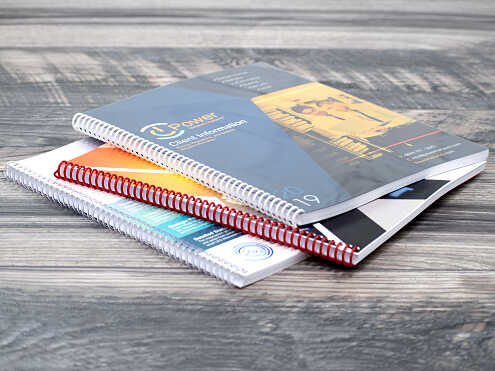Recognizing the Different Kinds Of Book Printing Options Available Today
In today's posting landscape, publishers and writers come across a range of Book printing choices. Each approach, from standard offset printing to modern electronic methods, supplies distinctive advantages and obstacles. Comprehending these choices is crucial for making educated choices. As the industry progresses, brand-new services like print-on-demand and self-publishing systems arise, providing chances for niche markets. The effects of these options can significantly influence the success of a publication. What should writers think about when picking their printing approach?
Offset Printing: The Traditional Method
Balanced out printing, a foundation of the posting market, is renowned for its efficiency and top notch outcome. This typical approach entails moving ink from a plate to a rubber blanket, which then applies it to the printing surface area. This method guarantees regular shade accuracy and sharp imagery, making it a favored option for big print runs.

Several publishers rely upon balanced out printing for its integrity and sturdiness, assuring that books endure the test of time. This approach not only supports standard posting yet additionally fulfills the needs of diverse genres and styles.
Digital Printing: Versatility and Rate
Digital printing has become a contemporary option to standard techniques, using considerable advantages in versatility and rate (book printers near me). This technology enables fast turn-around times, making it suitable for projects with limited target dates. Unlike conventional printing, which typically needs comprehensive setup and longer production runs, digital printing can fit smaller amounts without giving up high quality
It makes it possible for very easy adjustments such as changes in message or pictures, allowing authors and authors to make final modifications without incurring significant expenses. Digital printing supports a wide variety of products and styles, dealing with different creative requirements.
This adaptability reaches shade management and proofing procedures, enabling accurate color matching and high-quality results. Subsequently, digital printing has become a favored option for independent authors, little publishers, and organizations looking to create premium publications efficiently. In a progressively fast-paced market, its adaptability and speed are indispensable properties.
Print-on-Demand: Cost-Effective Solutions
While conventional printing approaches frequently need substantial upfront investment, print-on-demand (POD) provides a cost-efficient remedy that straightens with the demands of authors and writers. This model allows authors to publish publications as they are ordered, eliminating the need for large print runs and decreasing excess stock. Subsequently, authors can concentrate on high quality and material rather than stressing over storage and unsold duplicates.
In addition, husk allows writers to offer their books in different layouts without sustaining significant prices for each and every version. This versatility supports specific niche markets, permitting authors to get to certain target markets without economic threat. In addition, skin solutions commonly handle distribution, making it easier for authors to get their publications right into the hands of viewers. Generally, print-on-demand stands for a modern-day approach to posting, making it accessible for both well-known and new authors aiming to decrease economic obstacles while maximizing their creative capacity.
Self-Publishing Platforms: Navigating the Options
With the surge of print-on-demand solutions, authors now have more alternatives than ever before when it involves self-publishing. Many platforms have arised, each offering special features customized to various requirements. Amazon Kindle Direct Publishing leads the marketplace, allowing writers to release both e-books and paperbacks conveniently. IngramSpark is one more option, giving broader distribution possibilities, specifically for print copies in libraries and book shops.
Smaller systems like Lulu and Blurb satisfy niche markets, enabling writers to create aesthetically distinctive publications - book printers near me. Additionally, systems such as Draft2Digital and Smashwords help with electronic book distribution throughout several retailers, streamlining the process for authors
Selecting the right self-publishing system involves considering aspects such as costs, distribution reach, and customer experience. Authors must look into and assess their choices to locate the finest suitable for their publishing objectives, guaranteeing their work gets to the desired audience properly.
Eco-Friendly Printing: Lasting Choices for Authors
As understanding of environmental concerns expands, lots of authors are seeking environmentally friendly printing choices that decrease their carbon footprint - useful link book printers near me. Different lasting selections are now available, enabling authors to straighten their posting exercise with their values
One prominent alternative is utilizing recycled paper, which minimizes the demand for virgin products and lessens deforestation. Furthermore, writers can decide for soy or vegetable-based inks, which are much less dangerous to the environment compared to conventional petroleum-based inks.

Often Asked Concerns
What Elements Influence the Choice of Printing Approach for My Book?
The selection of printing technique for a publication is influenced by elements such as budget, print volume, wanted top quality, turn-around time, planned target market, distribution technique, and whether guide is hardbound or paperback.

How Can I Identify the most effective Printing Alternative for My Budget plan?
To determine the very best printing choice for a budget plan, one must evaluate costs, required top quality, print volume, and turnaround time. Contrasting various companies and methods can help recognize the most suitable and affordable choice.
Exist Minimum Order Quantities for Different Printing Approaches?
Various printing approaches typically have varying minimum order amounts. Digital printing normally provides reduced minimums, while balanced out printing generally needs larger orders to be economical. Each method's demands can significantly influence project preparation and budgeting.
What Is the Typical Turn-around Time for Each Printing Choice?
The regular turnaround time for different printing alternatives varies significantly. Digital printing usually offers the fastest service, usually within a couple of days, while countered printing may take weeks because of configuration and manufacturing requirements.
Can I Combine Various Printing Approaches for My Book Project?
Combining different printing approaches for a publication job is feasible. Writers may select countered printing for bigger runs and digital printing for smaller quantities, enabling versatility and cost-effectiveness customized to details project requirements and audience get to.
In today's posting landscape, authors and writers encounter a variety of Book printing alternatives. Electronic printing has actually come to be a favored choice for independent authors, small authors, More about the author and companies looking to produce top notch publications successfully. While typical printing approaches usually call for substantial ahead of time financial investment, print-on-demand go now (CAPSULE) offers an economical option that lines up with the requirements of authors and publishers. As recognition of environmental issues expands, many authors are looking for eco-friendly printing alternatives that decrease their carbon impact. Digital printing commonly supplies reduced minimums, while balanced out printing usually calls for bigger orders to be economical.